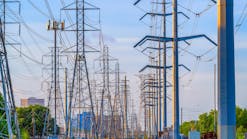As we confront the specter of another winter, the threat of extreme weather events and their impact on our grid is ever-present. The weather has been relentless in recent years – from the cold snap that put New England on ice in 2023, to the Winter Storm Elliot ravaging the country last December, to the heat wave that made the Pacific Northwest sweat in 2021. According to a NORC Center for Public Affairs Research poll, 87% of Americans say that they have experienced at least one extreme weather event in the past five years – by that calculation, most Americans have felt the strain that climate extremes inflict on our energy infrastructure. These, now commonplace, seasonal extremes are an urgent call to rethink how our grid handles these and other challenges.
Texas’s 2021 experience with Winter Storm Uri proves the adage that everything is bigger in the Lone Star State. The power outages resulting from that storm illustrate the severity of the predicament with our grid. During the storm, the Federal Energy Regulatory Commission (FERC) reported that consumer demand for electricity exceeded available generation capacity by an alarming 12 gigawatts. The situation became so dire that the Electric Reliability Council of Texas (ERCOT) ordered power providers to cut off customers, at one point totaling 20 gigawatts of demand, to prevent the grid from failing completely. The ensuing blackouts contributed to hundreds of deaths and billions of dollars in property damage.
Sadly, the storm in Texas was not an isolated event. The North American Electric Reliability Corporation’s (NERC) 2023-2024 Winter Reliability Assessment published this November issued a stark warning — more than half of the US could fall short on electricity supply during extreme cold events this winter. NERC’s assessment underscores the pressing need to ensure that our grid can withstand not only winter storms but the looming threat of any extreme weather events that create energy emergencies throughout the year.
However, there is a notable exception to NERC’s predictions. A key part of a resilient, secure grid is the exploitation of Distributed Energy Resources (DERs). New England’s grid operator put a new modeling tool to use and discovered that it has a sufficient winter power supply for the next few years, thanks in large part to the broad adoption of solar power. These types of DERs can have a profound and positive effect on system reliability if deployed at scale and managed properly.
Energy Flexibility Can Ring In A New Era Of Clean Reliability
Gone are the days when our power system relied exclusively on centralized fossil fuel generators. The modern grid is a series of interconnected networks supported by multiple DER assets like solar, wind, and long-term battery storage. These assets can generate, absorb, and store power to create a flexible grid that adapts to our evolving needs and relieves strain to the system. In this modern grid, our energy doesn’t have to travel as far, so there are fewer points of failure that can cause power disruptions during extreme weather events.
Centralized generation requires sending power over long distances via transmission lines, losing efficiency through multiple substations and vegetation-laden distribution lines before reaching homes. The power plants themselves are susceptible to unplanned outages for maintenance, while the T&D lines also require maintenance and can be vulnerable to extreme weather. Furthermore, depending on the location and elevation of a given substation, assessments of flood risk are also changing given varying weather patterns. Generating power on site reduces risks from extreme weather, isolating risk only to the demand site itself. Imagine a future where local battery storage and community solar projects come to the rescue during a power outage, ensuring that the electricity stays on at the hospital and the lights are restored at the retirement home.
So why is decentralized generation adoption not coming in massive waves? The process of converting our historic grid operation systems to this modern decentralized system adds layers of complexity and requires investment. Creating a modern grid calls for new technology and grid upgrades that can handle the dynamic nature of energy flexibility without causing further grid disruptions. As we invest in this future, it’s critical that we are mindful of cost and reliability. There are flexible market-based solutions that can help us take advantage of DERs while we continue on the road to a modern grid.
An energy flexibility marketplace, like Piclo Flex, can simplify the process of harnessing flexibility from DERs. Piclo Flex uploads aggregated DER assets to leverage them through an auction event that creates a flexible energy solution to grid challenges like meeting peak demand. The platform pays DER assets for the flexibility, adding an additional revenue stream to their operations.
There can be a disconnect between utilities and DER assets (where are the assets, how much energy can they provide, are they reliable?). A market-based platform can be a graceful intermediary streamlining transactions between the two - the utility sends out the signal identifying a challenge on Piclo and the DER aggregators are able to respond. Market-based flexibility can complement existing utility programs like demand response and peak shaving programs. With flexibility, a system operator can identify a challenge on the grid, narrow it down to any geographic location, and set up competitions for DER aggregators to respond to with bids. The competitive bid process manages costs, provides an immediate solution, and can be more-cost effective than traditional mitigation.
Already, National Grid plans to use Piclo Flex to harness over 100 megawatts of load relief solutions. This model keeps the price of energy down and enables system operators to easily harness the flexible assets in their region.
Flexibility as a Resource
To ready our infrastructure for the future, grid modernization needs to be a priority. The more intelligent the components of our system, the better we can harness its full potential. Integrating technologies like Advanced Metering Infrastructure (AMI), DER Management Systems (DERMS), and Advanced Distribution Management Systems (ADMS), allows operators to better visualize and manage grid assets (like DERs), which is foundational to accessing their potential value. Luckily, 47 states took action on grid modernization in 2023 focusing on things like energy storage deployment, utility business model reforms, and distribution system planning. There is positive momentum, but more comprehensive action is still needed.
Overcoming three market challenges can allow the value of flexible resources to be realized: [1] establishing the right regulatory incentives, [2] providing market access so value can be monetized, and [3] streamlining the interconnection process.
With the right regulatory incentives, we can utilize DER assets beyond just meeting peak demand during seasonal extremes. The flexible energy that DERs provide can be tapped during planned outages, to relieve grid congestion, and to help meet the increasing demands of electrification. There are alternative incentive models that better catalyze the evolution of our grid. For instance the Totex model for utility reimbursements is utilized in other countries to spur grid innovation in tandem with infrastructure upgrades, which are traditionally incentivized. Totex, shorthand for ‘total expenditure’, combines capital expense and operating expense into a single baseline the utility is measured against. This removes the capital bias and allows the utility to explore investment alternatives that better suit grid needs.
Another alternative earnings mechanism is called non-wires alternatives (NWAs). In an NWA, the utility defers network capacity upgrades on the T&D system by incentivizing DER adoption. In today’s cost-of-service model, the utility prefers to invest in capital and would yield all of the deferral savings back to the customer. In a NWA construct, the utility is able to gain-share with the customer on the value of the capacity deferral, not only removing the capital bias but also rewarding the utility for preserving optionality based on future demand projections. Changing rate designs that enable DER participation is far less costly than being stuck with a substation upgrade that lasts decades where the demand never materialized.
Second, market access is critical for DER so that the value they provide to the grid can be realized and shared with the customer. FERC Order No. 2222 requires independent system operators (ISOs) to allow such access, but due to the complexity of decentralized resource integration and the myriad of participant types, ISOs have been cautious to define and implement the rules.
The system needs to change in order to get different results. We need regulatory structures that embrace DER solutions alongside traditional grid build out, like NWA solutions. On the other side of the equation, system operators need to incorporate solutions like NWA, battery storage, and DER systems in their investment planning in meaningful ways.
To build the onramp to a new regulatory environment we need more opportunities for innovation. That means more opportunities to demonstrate innovative solutions that can test new market structures and design thoughtful regulations. Utilities are inherently taking on more risk integrating with these frequently intermittent and distributed resources. These types of programs give peace of mind to utilities allowing them to establish operating protocols and understand how these assets will behave under varying grid conditions before deploying at scale.
How Do We Prepare For the Coming Storm?
The grid strain and outages caused by extreme seasonal temperatures demands innovative solutions. The proliferation of DERs offers a ray of hope, as these assets can provide on-site services and reduce grid strain through energy flexibility. Texas is again a poster child, this time for the solution. In the wake of the 2021 storm, they turned to battery storage to provide additional electric capacity to stabilize the grid. Since 2021, energy storage capacity in Texas has increased roughly tenfold. With more than 3,000 megawatts of battery storage available, ERCOT was able to tap into batteries to avoid power outages during this summer’s heat waves. They were able to use energy flexibility to bolster grid resiliency and manage changes in demand brought on by seasonal weather extremes.
This sort of systemwide evolution calls us all to engage. It will require participation from energy innovators, DER developers, utilities, regulators, and customers to ensure that we make the necessary changes to build a modern and resilient grid. The problem is multifaceted and so must our efforts to bring about the solution. The path forward must be paved with proper regulatory incentives that value DER and promote innovation, increased market access and systems planning for DERs, and a more streamlined process for interconnection. Moreover, this process should have clear benchmarks for progress that meet the growing challenges with the urgency they demand.
It's time to prepare for the storms on the horizon by building more adaptable and sustainable energy infrastructure. With widespread engagement we can create a grid that stands up to the winds of a changing climate; one where there is more reliability, energy prices are more competitive, and energy generation is cleaner.
John Greene is policy and regulatory affairs manager at Piclo, and Tim Snyder is VP, Public Policy & Government Affairs, Northeast Clean Energy Council.


